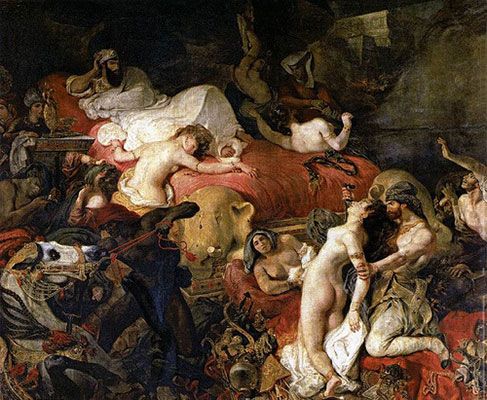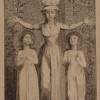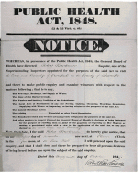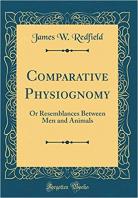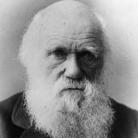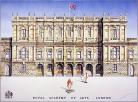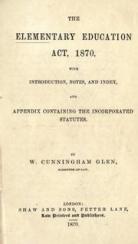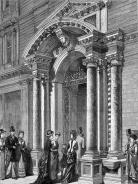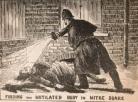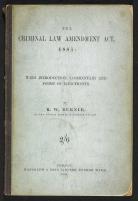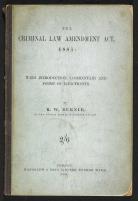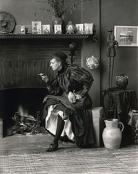Timeline: CCU ENGL 300
Created by Kate Oestreich on Tue, 09/01/2020 - 09:47
Part of Group:
See "Adding Timeline and Map Entries" on "The COVE" Moodle tile.
Timeline
Chronological table
| Date | Event | Created by | Associated Places | |
|---|---|---|---|---|
| 1848 |
The Pre-Raphaelite BrotherhoodArtistry had a longstanding foothold in European society, as famous artists such as da Vinci, Michelangelo, and Rembrandt were dedicated figures and perceived as more than man. In 1848 a group of English painters, poets, and art critics founded the Pre-Raphaelite Brotherhood, a collective experience designed to return nineteenth century European art to that of the Quattrocento Italian art. The Quattrocento period refers to all Italian art created between 1400-1499 which consisted of an abundance of detail, vivid color aesthetics and complexity. The group directly rejected the Mannerist artists, the form of art that gained exposure around 1520 succeeding Raphael and Michaelangelo. Specifically the group rejected the teachings of Sir Joshua Reynolds, the founder of the English Royal Academy of Arts. They found the teachings and artistry of Reynolds to be lackadaisical, thoroughly absent of complexity which to the Brotherhood was a direct insult to artistry as a whole. The group was subject to harsh criticism as they were seen as very backwards facing, understandably so as the world of art is constantly looking forward yet this group fought viciously to return to a more medieval style of painting. One of the groups’ most notorious critics, Charles Dickens, who had become thrown into the spotlight of Victorian England found the portrayal of the Holy Family “blasphemous” and found their entire style backwards- looking and simply ugly. Ah, Basil, I recently viewed the work from John Everett Millais and I must say it is most certainly butter upon bacon. His Christ in the House of His Parents holds no standing in my opinion, in the cast contrary to yours dear Basil. You exercise such amazing beauty unlike that absurd Pre- Raphealite Brotherhood, how grotesque and backwards! I have no such understanding for artistry that seeks to live in the past, unlike your portraits. Don’t sell me a dog! I would be half rats to consume any more abominations from that group, how dare they condemn the teachings of Sir Joshua Reynolds. Perhaps I am just cynical, or perhaps I am astonishingly self aware. Alas, art is for the artistry’s sake and you, Basil, are an artist unlike any other. Works Cited Pre-Raphaelite Brotherhood. (2020, October 03). Retrieved October 27, 2020, from https://en.wikipedia.org/wiki/Pre-Raphaelite_Brotherhood Wilde, Oscar. (1890) The Picture of Dorian Gray. [online] Available from: Cove Studio [Accessed September 2020] |
donovan moore | ||
| circa. Summer 1848 |
Potato FamineThe Irish Potato Famine started to occur in 1848, this caused many people to go hungry and lose a lot of money in Ireland as most of the Irish crop was potatoes. I thought that this was relevant to The Tenant of Wildfell Hall, because Gilbert Markham is a farmer and he could have easily been affected in some way, probably by people from Ireland wanting to get some potatoes so they don't lose as much money or go hungry. Jack, mostly everything is fine here at Linden-Car Farm, Mom's good, Rose and Fergus are still concerned about that darn famine with the potatoes in Ireland, Fergus doesn't really understand what's going on or where our potatoes are going, that boy's too young to understand. They say there's almost a million victims of the whole thing, think last I heard it was around 840,000. This season's been pretty rough, but we'll be okay...famine won't hit us too hard. Though apparently there's some new thing called potato blight affecting what potatoes and tomatoes we do have and also cholera is coming back, so it looks like we might be in for a quarantine here pretty soon. Should only last for 3-4 weeks as long as everyone does what they're supposed to do. |
Ben Hestad | ||
| 31 Aug 1848 |
The Public Health Act of 1848The Public Health Act of 1848 was the first step in paving the road to improving public health. In 1842, Edwin Chadwick published his essay, "The Sanitary Condition of the Labouring Population of Great Britain," paying the price of publication himself as the Poor Law Commission did not want to be associated with it. In his report, Chadwick argued that spending the money to improve public health would be cost effective, as less people would seek poor relief if the health of the poor improved. He considered the most important steps in improving health to be bettering drainage and sewage systems, removing wastes from homes and roads, ensuring clean drinking water, and appointing a medical officer in each town. After yet another severe cholera outbreak in the summer of 1848, the government was forced to act and passed the Public Heath Act of 1848. This Act established a Central Board of Health, but it had limited powers and no money; it provided a framework that could be used by local authorities, but could not compel much action. Even though the Public Health Act of 1848 may not have been able to ennact much action, it started the conversation and paved the way for improvements in health to happen. Dearest Paulina, Will my woes never be alleviated? Will I never find peace in this cruel world? So many lives that I love have been lost--and what am I to do? Benjamin held a high temperature for the last fortnight and stopped taking water Sunday afternoon. He claimed he was so thirsty, yet the well water seemed to worsen his countenance. I remained by his bedside during the day, cleaning after his messes and messes against his own person. My dear friend, he appeared in his doom but mother assured me of his recovery! Alas, she told a lie! This morning, when I entered to change his bed cloths, I found my dear brother laying cold and green. He would not respond to my inquiries of his countenance; he would not respond at all. I held my pocket mirror to his nose and alas, no fog! My dearest brother, dead! And now, I am plagued with a deeper fear, for I have noticed my mother is of lower spirits than usual, and has had trouble keeping her meals ingested. I fear, Paulina, that my mother will meet the same doom as Benjamin, and what am I to do? How, Paulina--how did you remain composed in your father's illness? How did you keep your faith and hope? I must be strong, but who will be here if she leaves? What will become of me if my home becomes grave? I am not yet married, and will surely have to find work to support myself--but my friend, as a governess? I fear such a life of seclusion! I fear being alone, Paulina! I fear that the health of my loved ones will never improve, but I would rather perish in their same fate than live a life alone! Works Cited "The 1848 Public Health Act." UK Parliament, 2020, www.parliament.uk/about/living-heritage/transformingsociety/towncountry/towns/tyne-and-wear-case-study/about-the-group/public-administration/the-1848-public-health-act/. "Local Board of Health." Wikipedia, Wikimedia Foundation, 29 May 2020, en.wikipedia.org/wiki/Local_board_of_health. "Public Health Act 1848 and the General Board of Health." Policy Navigator, 2020, The Health Foundation. navigator.health.org.uk/theme/public-health-act-1848-and-general-board-health. |
Savannah Funderburk | ||
| 14 Aug 1850 to 14 Aug 1850 |
The Public Libraries Act 1850The printing press and subsequently the phenomenon of reading for pleasure had long been around Europe, but unfortunately this luxary was mainly concetrated with the wealthy who had much more free time and a could afford to purchase essentially their own private liraries. After a long adjustement from an agrarial society through the industrial revolution the middle class was left with much more free time on their hands, so the idea to promote reading and other educational activities for the poor to spend this free time more wisely came from those in power. The Public Libraries Act 1850 was an act of the United Kingdom Parliament which first gave local governments the right to establish a free public library. This act was the first step towards an organized institution designed for free access to information which reflected the changing moral and social views on education at the time. There was certainly a bit of controversy regarding the passing of the Act as many felt as if they were being taxed without consent, however there was an overwhelming majority in favor of providing this information free to the public. After the first U.K. public library was established in Winchester in 1851 there are now 4,145 free to the public libraries throughout the U.K. Dear friend, I fear my life has become rather butter upon bacon lately, I have struggled with the closing of my family's farm and with it the changing of our identity. That being said, I have left for London in search of work, and perhaps a taste of what more I could enjoy in life. I had recently spoken with a dizzy aged church bell, and while she held my attention hostage she did offer me a helpful insight to explore the new library. I decided literature was the necessary salvation for my untested mind and decided to read Charlotte Brontë's Villette. Aye friend, what a marvelous decision that would be as I feel as if I can explore my thoughts with much more intensity than ever before. However, I must admit to the feelings of anger while consuming the novel in which there is much discussion of a study in the House of Bretton. I cannot help but to feel contempt for this fact as knowledge has recently been proven to hold enormous power yet the rich are able to hold the majority with their ability to have in home studys. I will continue to make use of my newfound freedom from mental incarceration by continuing to consume as much literature as my mind and spirit can. Ah my dearest friend, ah humanity! Bronte, Charlotte. (1853) Villette. [online] United Kingdom: SMith, Edler & CO. Available from: Cove Studio [accessed September 2020] Public Libraries Act 1850. (2020, February 28). Retrieved September 21, 2020, from https://en.wikipedia.org/wiki/Public_Libraries_Act_1850 |
donovan moore | ||
| circa. Spring 1851 |
1851 Religious CensusAs we know, religion is a prime theme in the novel that is one of the elements that keep Helen and some of the other characters humble. Helen's course of action in the midst of her plight reflects her strength and her trust in God. After our discussion in class, I realized how I didn't really consider Helen's Christian journey and how that is such a huge factor in her character development. As someone said in class, Helen is a product of her environment and religion was a prime platform that kept people motivated and stable. The Tenant of Wildfell Hall does a great job of displaying the different opinions and personalities that people adhere to within the Christian belief. This now leads me to the census of 1851 which displays the opposite of Helen's strife and values about the Christian faith. In the decennium census survey, of 1851, it was discovered that eighty percent of the supporters who visited welsh places of worship were non-conformists while the remaining twenty percent supported the established (catholic) church. Another thing to consider is secularism went mainstream in England a few years after the set timeframe of the novel. Hints why the census read the way it did. In addition to this, some believe that the results may be skewed because a fifth of the entire population was said to be Anglican while about two-fifths of the population didn't attend church at all (BBC). This was a shock to many in the public eye but they failed to consider those who fall below the poverty line, and the sick and shut-in. Also, this was Britain's one and only religious census. This leads me to believe that whoever was in charge at the moment didn't want news reflecting that the Church of England was losing its fire and that people were now Baptist, Prebestrysterian, Methodist, Calvinist, or etc. This is the turning point in history where followers began to expand within the Abrahamic religion and branch off into a sect that fits better with what they believe in. Works Cited BBC."Victorian Britain" BBC History. Accessed 28 Nov 2020. http://www.bbc.co.uk/history/british/timeline/victorianbritain_timeline_... BBC. "Religion in the Nineteenth and Twentieth Centuries."BBC Wales History. Accessed 28 Nov 2020. https://www.bbc.co.uk/wales/history/sites/themes/guide/ch16_religion_19t...'s%20one%20and%20only%20religious,Wesleyans%2C%2012%3B%20others%202. |
Evonne Sherman | ||
| The start of the month Spring 1851 to The middle of the month Autumn 1851 |
the Great ExhibitionOn the day of May 1st, 1851, hundreds upon thousands gathered around from near and far to view the opening of the Great Exhibition also known as the "Crystal Palace" in London, UK. The Great Exhibition was an idea coined by Prince Albert who had dreams of displaying all of the wonders that this world has to offer in one place for all to view. The exterior of the place was grand in nature and was surrounded with glass windows and pannels, almost fairtyle esque. The construction of the palace took well over 5,000 workers to build the 1,850ft long and high 108 palace. (historic-uk) . Within the exhibtion housed over 100,000 objects that was diplayed over 10 miles submitted by 15,000 contributers from across the globe. The palace included the most famous and grand marvels of the Victorian era such as pottery, ironwork, porecelin, hydraulic presses, grand pianos, steam hammers, and much more. Some of the foreign contributers included France, Russia etc with France being the biggest contributer in which they submitted beautiful porcelain and silk enamels. Attendance at the Great Exhibition quickly became one that was frequently visited by the bourgeois and even commoners on specific days.Everyone arrived in their best dressed garments,and hand tailored suits seemed by the finest seemstress from all over the globe. By October 11th, the final day, attendance exceeded well over 6 million people and made a profit of 186,000 pounds. Work Cited “The Great Exhibition 1851.” Historic UK, www.historic-uk.com/HistoryUK/HistoryofEngland/Great-Exhibition-of-1851/.“The Great Exhibition. ” The British Library, The British Library, 13 Mar. 2014, www.bl.uk/victorian-britain/articles/the-great-exhibition. “Great Exhibition.” Wikipedia, Wikimedia Foundation, 8 Sept. 2020, en.wikipedia.org/wiki/Great_Exhibition. |
Taylon Anderson | ||
| 1852 |
"Comparative Physiognomy" PublishedPhysiognomy was a popular method of character study in the Victorian Era, in which one would "objectively" deduce a person's morality or personality based on their physical attributes alone. While physiognomy has a deep, intercultural history stretching back far before the 19th century, the practice wasn't widespread until the early 18th century, when European scholars began to develop theories surrounding its' merit as a credible scientific practice ("Physiognomy"). With this cultural emergence in popularity, English authors such as Charlotte Bronte began to employ physiognomy in their writing as a means to not only describe a character's appearance but to also provide the reader with context as to whether or not a character's appearance would fit within the contextual conventions of attractiveness in the depicted society. For example, in Villette, Mme. Beck employs M. Paul to scan Lucy Snowe's facial features as a quick judge of her character to determine whether or not she should be permitted entry into the pensionnat (Bronte). One year before Villette was published, Comparative Physiognomy by James Redfield was published in the United States in 1852-- showing how the scope of this phenomena extended beyond Europe, into the New World. In Comparative Physiognomy, Redfield compares human attributes and their level of trustworthiness to characteristics of wild animals, similar to Bronte's description of Graham's red hair in Villette as "lion's locks" (Chap. III). In modern times, physiognomy has become seen as a pseudoscience that was used previously as a means to justify prejudice against unconventional appearances. Presently, I still find myself aghast from this most stunning revelation in regards to the "esteemed" Dr. John. How could a figure depicted so benevolently be revealed a miscreant so foul as Graham Bretton? Surely, a man so practiced in physiognomy such as M. Paul could not look into the eyes of a demon and allow him passage into the pensionnat of his own beloved cousin! I fear the savage's favorably fair skin, Celtic lineaments, and otherwise facetious disposition have blinded M. Paul of any sensibility. Moreover, I pray this revelation of Dr. John's true identity to not be prophetic of impending calamity. Still, I ponder how his transgressions can go seemingly unnoticed. Is his countenance of sin not clear as day? Do his auburn locks not conjure up an imminent betrayal akin to that of Judas? Alas, it would not be the first time one of his kind has hidden their perfidious nature. Ere long, the light of day will shine upon his mane of "chestnut" and reveal those hidden shades of hellfire. I pray this happens before he corrupts any more souls of the people of Rue Fossette. The global physiognomic studies of man, as provided by God and science, prove him guilty. My conjecture predicts this beastly lion has masked his indignant machinations through the subtle malpractice of his profession. Oh, how sardonic his fate has proven! No doctor could craft a draught to cure such a malady, no repentance could heal the afflictions of inherited sin. Works Cited Bronte, Charlotte. "Villette." COVE Studio, 2020, https://studio.covecollective.org/documents/villette-2. Accessed 12 Sept 2020. "Physiognomy" Wikipedia, Wikimedia Foundation, 14 Aug 2020, https://en.wikipedia.org/wiki/Physiognomy. Accessed 12 Sept 2020. Redfield, James. "Comparative Physiognomy: or, Resemblances Between Men and Animals (1852)." The Public Domain Review, https://publicdomainreview.org/collection/comparative-physiognomy-or-res.... Accessed 12 Sept 2020. |
Kyle Blandford | ||
| 1853 to 1856 |
Crimean WarThe Crimean War was a war that was long coming. Before the Crimean War, there were smaller wars that lead to this war. The Greek War of Independence War began in 1821. This made internal and military weakness in the Ottoman Empire. France took this opportunity to take Algeria in 1839. The Ottoman forces were defeated making the treaty "Unkeriar Skelessi, depriving Russia of its right to block warships from passing in the Black Sea. The French Empire wanted to force Roman Catholic over the Christian population of Palestine. This caused a war to fight for Christian minorities in the Holy Land, a part of the Ottoman Empire. The long term reason for the war was the decline of the Ottoman Empire along with Brittian and France to allow Russia to gain territory and power at the Ottoman Empire. The Crimean War was the turning point for Russia's influence. This war had great effects on Russia as they had lost. I was sitting in the chair watching Graham looking sad about Ginevra's behavior at the ball last night. Mail suddenly came to the door, this was rather odd. Mail usually did not come quite often. It was for Graham, perhaps someone who shared affection for him. As he read the letter his physiology change to long anguish. I sat there wondering what could have been in that letter. Dr. John soon turned to me, He said, "I am needed in war, Lucy." How could they recruited Graham, what good could he do in the war? He would be better off here taking care of his patients. I stay silent waiting for him to speak. "They need me to help wounded man, how am I supposed to leave mama." Dr. Johnn always worried about Mrs. Bretton, She would be fine on her own. I do not want Graham to put himself in danger but there is not much, that I can do. "Graham it is a pity that you have to leave." I am unsure of how I feel, as Dr. John has been so kind to me. I worry about his safety. "Lacy, I will write to you so you are not alone, but you must write to me. I will worry about you and my mother, will you check on her for me, do tell me all is good when writing to me." I really feel perplexed as I just want to stay at the school. Though, it is my duty to check on Mrs. Bretton since Graham was so nice to me. I obliged to what Graham said. "I shall write to you." He smiled, gave his mom a hug, and went on his way. I did not see Graham for quite some time, how I missed him. Sources: "Crimean War." Wikipedia, Wikimedia Foundation 3 Sept. 2020, https://en.wikipedia.org/wiki/Crimean_War#Immediate_causes_of_the_war "History: British History Timeline." BBC, BBC, 2014,http://www.bbc.co.uk/history/british/timeline/victorianbritain_timeline_noflash.shtml. |
desiree calhoun | ||
| Spring 1853 |
First Public AquariumAccording to Wikipedia, “The first public aquarium was opened in London Zoo in May 1853.”(Wikipedia, 2020) This public aquarium was known as the Fish House. This set the stage for other new and enthusiastic public attraction owners and up and coming attraction owners such as P.T. Barnum to follow suit with their own aquarium attractions. Barnum’s aquarium was established in 1856 as a part of his American Museum located in Broadway in New York City until unfortunately it burned to the ground. I think that people living in 1853 England would find this concept of a housing of aquatic animals to be very strange and kind of alarming with the only thing between their families and themselves and these massive sea creatures being a pane of glass.
I take another drag of my pipe as I read the final headline that will grace my eyes in the morning's paper. "Martha, what's this I'm reading about this here ‘public aquarium’ at the London Zoo? Says here it’s the first of its kind, but I can’t seem to figure out what in tarnation the damn thing is! What say we take the kids the day after tomorrow, huh?” “Well that sounds lovely, George.” “Great, pack your things, I still don’t know what the hell this damn thing is, could be gone for a whole month, hell maybe even a year! You’d think they would advertise these things a little better don’t ya think, Martha?” “Yes, George.” “You think little Billy and Annie would like it?” “I don’t know, George.” “Gah, what the hell. They’ll love it. You’ll love it. I’ll probably hate it, but that’s what I’ve got me pipe for, ah?” “Yes, George.” I turn to the back page of today’s paper, the funnies page. “Aha, Martha come here you’ve gotta see this. You’ll never guess what this little pussycat did! He kicked his milk off the table and *wheezing* and then *more wheezing* he drank it off the floor!” “Yes, George.”
“1853 In the United Kingdom.” Wikipedia, Wikimedia Foundation, 16 June 2020, en.wikipedia.org/wiki/1853_in_the_United_Kingdom. “Public Aquarium.” Wikipedia, Wikimedia Foundation, 28 Aug. 2020, en.wikipedia.org/wiki/Public_aquarium. |
Ben Hestad | ||
| Autumn 1854 to 1855 |
Cholera Outbreak of 1854On a muggy, September 7, 1854, Cholera swept the streets of Soho, London. Over 500 residents left dead in the streets and homes after this pandemic quickly and fiercely took over. Casually classsifed as the poor people's disease, the first case came out of India, which then later progressed to Russia and shortly after arrived on the doorsteps of England. Cholera is a diarrhoeal infection that occurs when you ingest food or water that is contaminated with feces, scientically labeled as the bacterium Vibrio Cholerae. The onset for Cholera is sudden, vomiting and diarrhea occur - to the point where your body cannot maintain enough fluid and nutrients to filter the rest of your body's organs. At the time, science was still in the dark, leaving Epidemioligists pondering the method of transmission. During this era, water systems and most water companies would share their main accessability where cesspits would be emptied. The sewage would be flushed into the water supply where people got their drinking, cooking and bath water. John Snow, whom at the time was a doctor specifically studying Cholera, went door to door surveying local families and mapping the disease to figure out what tied each death together. Eventually leading to the discovery that the main water pump providing water had been contaminated. Cholera changed the way we studied medicine and the factoring of how to determine how diseases are spread. Also, it created a huge milestone for medicine and epidemiology at this time. Dear Ruthy, It has been some time since we talked last and I haven't been much of a church-bell, but events here in Soho have been wretched and I have been disconsolate. We've been trying to imbibe Benjamin to keep him from falling ill but I am afraid it is too late, he has not been up to dick. I haven't slept in quite a few days, I find myself pondering the thoughts of what it would be like to survive this mania with my three beautiful girls. I try to hide my agony as much as possible, so they do not see the despair on my face. I can hardly sleep, I have been watching the night-soil men as they carry days worth of communal waste from places I wouldn't attempt to endeavor, bless their souls. Mafficking at every corner, fear embelishes our tired hearts but I still have hope for myself and my babies. Benjamin has been on rest all morning, his symptoms do not seem to show us he is wilting but he has been working fortnight trying to contain the spread. I see the colour leaving his face, I noticed he is more flushed as of recently. I smile, thinking of the family I have kept from misfortune but I weep in darkness at the matter of inequality. Death is sweeping like a broom in the hands of a degenerate employed by the lovely Queen. My love never fades for you, tell Papa and Mother I send my best regards. With love, Genevieve Center of Disease Control , CDC. “General Information.” Centers for Disease Control and Prevention, Centers for Disease Control and Prevention, 11 May 2018, www.cdc.gov/cholera/general/index.html. "History of Cholera: Outbreaks & Timeline." Study.com, 3 February 2017, study.com/academy/lesson/history-of-cholera-outbreaks-timeline.html" |
Tyler Bass | ||
| 1857 |
Matrimonial Causes Act of 1857The Matrimonial Causes Act of 1857 was one of several acts passed by Parliament from 1857 to 1878, reforming the law on divorce. Before 1857, divorce for the average person was almost impossible, especially for women. Women were under complete control of her husband, and had no power if he was having an affair, or abusing her in any way. The law required proof of adultery of either party, but a woman also had to show proof of cruelty from her husband. However, a woman could still lose custody of her children if she was found guilty of adultery. In addition, because women’s property became their husbands after marriage at this time, if a woman attempted to separate herself from her marriage, her husband would retain legal claim over all of her assets. The threat of being left with no money and the loss of children forced many women into staying in a bad marriage. By passing the Act, divorce became a matter of the court rather than church which was opposed by many, the Church of England being the biggest opposer. A huge advocate for divorce reform in order to give women rights was Caroline Norton, an English social reformer, and author of such works as “Brief Summary in Plain Language of the Most Important Laws Concerning Women”, and “English Laws for Women in the 19th Century”, among many others. Norton’s own marriage was abusive, and the trappings of marriage under law at this time inspired her to rally for change, and protection for women. She even wrote desperate letters to Queen Victoria, pleading for help for all the women trapped by their husbands, which had a major influence on getting the Act passed by Parliament. The Tenant of Wildfell Hall was published in 1848, with the novel taking place in the 1820s. Bronte used the character of Helen Huntington to address the unfortunately common occurrence of women trapped in bad and abusive marriages. Had this act existed when the novel took place, Helen would not have had to resort to running away and living in hiding in order to remove herself and her son from her husband's influence. https://en.wikipedia.org/wiki/Divorce https://www.britannica.com/biography/Caroline-Norton
|
Sarah Henning | ||
| 24 Nov 1859 |
Charles Darwin: "On the Origin of Species" was PublishedCharles Darwin presented himself as a radical of the 19th century, defying the natural order of religious-based reasoning, and introducing an alternative scientific perspective on human existence. On November 24th, 1859, Charles Darwin shook the religious demographic of the 19th century with his book, On the Origin of Species by Means of Natural Selection. It was in his book that Darwin argued the evolution of a species through the process of natural selection: a process in which a species develops or evolves based on the environment in which it lives, as the environment directly impacts the genetic makeup of an organism. Darwin's book immediately sold out. It was greatly appreciated by his fellow scientists because of its offering of an additional and new source of knowledge and scientific reasoning. On the other hand, those of the Christian faith denounced his book, claiming it to be a heretic act against the church. This divide between science and the Church would prove to be problematic as many would begin to question the biblical explanation of creation. It wouldn't be until 1871 that Darwin would publish another book, this one called, The Descent of Man, and Selection in Relation to Sex. This book would take on his theory that humans evolved from apes, once again causing a stir in the Church, threatening the beliefs they sought to maintain. It wasn't until his death in 1882, that his theory became somewhat accepted amongst the general public, encouraging further research of scientists that would follow, though still posing as a continuous threat to biblical explanations. I cannot begin to fathom the book that is, On the Origin of the Species by Means of Natural Selection. I must bid a prayer to our Lord in hopes that this abomination of sinful thought dare not take flight. Who is Darwin to introduce such blasphemy? He, who makes such claims against our beloved Church and our holy creation, is nothing but a non-believer and a heretic of our day. And to think that there are others who squander their thoughts in such foolishness! It is the mission of God's followers here on this land to preach the words of his greatness and to gather those who share in his grace. Anyone not willing to share in his grace and in the teachings granted to us through our Holy Bible, pose as a threat and must be purged from our lands. We must continue to pray to our Lord that the words of this dissenter do not harm what has always been. The Protestant faith has done enough, we will not add to this sacrilege anymore. To allow such a thing would mean that we have failed. But nay, failure must not be an option for I would not be a follower of the faith if I had let it. “Charles Darwin.” Biography.com. A&E Networks Television, August 28, 2019. https://www.biography.com/scientist/charles-darwin. “‘Origin of Species’ Is Published.” History.com. A&E Television Networks, November 24, 2009. https://www.history.com/this-day-in-history/origin-of-species-is-publish.... |
Michaella Maddalena | ||
| 1860 |
First Female Artist enrolled to Royal AcademyEven though the prestigious Royal Academy of Arts was founded in London in 1768 with the help of two women, no woman was ever enrolled to the Royal Academy Schools for the study of academic art until 1860-- and the two founding female members were scarcely referenced or formally recognized by the other founders ("Women Artists"). Laura Herford made history by being the first woman to be enrolled as a student to the Royal Academy Schools in 1860. The official public allowance for the admittance of women to the Royal Academy was not officially recognized until 1861, despite petitions for women to be accepted to the Royal Academy being submitted since the 1840s. Even though her career as an artist was short-lived due to her death in 1870, Laura Herford made history by being admitted to the Royal Academy Schools by signing her drawing applications with the vague initial, "L. Herford." It was assumed that the ambiguity of her signature helped mask her gender from the admissions tutors, but she was offered a position regardless based solely on the merit of her artistic rendering ("Laura Herford"). Published in 1848, The Tenant of Wildfell Hall by Anne Bronte directly addressed some of these long-standing issues of respecting women's' representation in the field of professional art by Bronte writing a female artist character named Helen Graham who challenged the cultural taboo of women making a profession out of art-- especially as a means to live independently (Bronte). Helen Graham had to use similar tricks to the real-life Laura Herford, such as misconstruing her name/gender and sending her works away to be sold for compensation through a third party. Although movements towards professional female artists being culturally acceptable didn't flourish until after the death of Anne Bronte in 1849, women like Laura Herford helped female artists alike get their foot in the door and begin to be recognized as equal-- changing the problematic threshold of conventional art culture as Bronte criticized throughout The Tenant of Wildfell Hall. Works Cited Bronte, Anne. The Tenant of Wildfell Hall. 1848. The COVE. https://studio.covecollective.org/anthologies/frankenstein-or-the-modern.... Accessed 29 Nov 2020. "Laura Herford." Wikipedia, Wikimedia Foundation, 4 May 2020, https://en.wikipedia.org/wiki/Laura_Herford. Accessed 29 Nov 2020. "Women Artists." Wikipedia, Wikimedia Foundation, 27 Nov 2020, https://en.wikipedia.org/wiki/Laura_Herford. Accessed 29 Nov 2020. |
Kyle Blandford | ||
| 1861 |
Legislations of Domestic ViolenceOffences Against the Person Act 1861 is where Parliament in Britain. This act had no laws on the criminalization of violence against assaults. personal injury, short of murder. The judges did very little or nothing at all. In the 1800s Queen Elizabeth made it where you could not lock up or beat your wife that could lead to death is reason enough for divorce. The Matrimonial Causes Act 1878 helped people of violence in marriage to separate orders if her husband created aggravated assaults. This was due to woman's emancipation, seen as leveling up morals and aim to prevent sinfulness. This shows how a man could treat a woman however he wanted with no consequences. Before these were even put into place women were seen as property. Even with these legislations it is still was virtually impossible for a woman to get a divorce. Many women were probably stuck in an abusive relationship. Sources: "History of Domestic Violence and Legislation in the UK." ukesseys.com. 11 2018. UKEssays. 12 2020. https://www.ukessays.com/essays/criminology/literature-review-domestic-violence.php "Offences Against the Persons Act 1861." Wikipedia, Wikipedia Foundation, 29 Sept. 2020. https://en.wikipedia.org/wiki/Offences_Against_the_Person_Act_1861#:~:text=The%20Offences%20against%20the%20Person,of%20Great%20Britain%20and%20Ireland.&text=It%20is%20essentially%20a%20revised,Act)%2C%20incorporating%20subsequent%20statutes. McKenna, Kelly. "The Changing Nature of UK Divorce Law." The Changing Nature of UK Divorce Law\ In Custodia Legis: Law Librarians of Congress, 5 Aug. 2019, https://blogs.loc.gov/law/2019/08/the-changing-nature-of-uk-divorce-law/#:~:text=However%2C%20the%20Matrimonial%20Cause%20Act,judicial%20separation%2C%20not%20a%20divorce.&text=The%20Divorce%20Reform%20Act%201969,marriage%20has%20broken%20down%20irretrievably. |
desiree calhoun | ||
| 1870 |
Elementary Education Act of 1870Also known as Forster's Education Act, the Elementary Education Act of 1870 was the first of many acts that set standards for the education of children between the ages of 5 and 12. This was a huge milestone for the time and came about as an expressed need to educate the recently-enfranchised public thanks to the Reform Act of 1867. Despite the influx of votes the Reform Act procured, it still mainly applied to men. Therefore, as a result, the Education Act primarily focused on boys. It was still considered inclusive, however, since it pertained to school-age children as a whole population. Although not highly reformatory in regards to education as a whole, it set the stage for later reforms to give education to the masses, especially in areas that were lacking educational opportunities before the Education Act. This is especially progressing for women's education, which had been discouraged by many due to the popular belief that education lowered women's reproductive health. This resulted in college being a fairly taboo action for women, particularly before education reform began taking place towards the end of the Victorian Era. This is highly contradictory considering that one of the few socially-acceptable career choices for unmarried women was being a teacher. Lucy Snowe, as a professional young woman, has garnered herself a respectable reputation has a school teacher with Madame Beck. She commands her classroom and properly teaches young children English, as a young woman should. Even without an education, it doesn't take much of a woman to know that she should be highly regarded. Not only does she conduct herself well in the classroom, she learned all of that without proper education herself! While it's evident she had been taught as a young girl, she received no instruction for the management of youths, many of whom are in a similar boat as her, I'm sure. Though, on that topic, her education may be a reason she has yet to wed. After all, should she wed she wouldn't have all of the financial troubles that have woefully possessed her life up until this point. That is just one reason women don't need much formal education; if they get along with learning on the job until a man comes to save them from financial troubles, there's no need. I myself get along just fine; my husband earns a wealthy wage and my children are the light of my life. What more could an English woman ask for? works cited: https://en.wikipedia.org/wiki/Elementary_Education_Act_1870#Effects Villette by Charloette Bronte |
Melanie Schlesser | ||
| 1870 to 1882 |
Married Women's Property Act of 1870The Married Women's Property Act of 1870 isn't expressly alluded to within the text, but it does relate to the state in which women are treated at the time. The Property Act allowed women to keep the money and property they earned, rather than it being credited to their husbands. Prior to this, women were seen as the property of their husbands, and thus everything the women would own went towards her husband. The husbands then could even purge the money as they saw fit whether or not it was initially theirs to begin with. With the Act, wages earned by the wife were kept separate from her husband's. Women could also hold and inherit rental properties. There was also a section that made women financially liable along with her husband for their children. While this is definitely leaps and bounds above where Helen and other women were situated in the novel, there were still shortcomings. It mostly dealt with the earnings of a woman and not so much her property rights. it also lacked any retroactive aspects, meaning women like Helen wouldn't have been able to be considered financially separate from their husbands after marriage. Some criticism of the Act pertained to the notion that it didn't seem bent on actually helping women but rather by limiting any potential fraud from married couples looking for extra cash. There also wasn't much explicit equality resulting from the Act since in many ways women were still very much viewed as the property of their husbands by social standards. The Act was later repealed in favor of more substantial laws. |
Melanie Schlesser | ||
| Mar 1874 to 1895 |
EgyptomaniaThe discovery of the pyramids at Giza and the Sphinx have fascinated citizens of the world for thousands of years. Since Napoleon’s invasion of Egypt in 1798, much of Europe had made it a priority to discover as much of the artifacts as possible. Little of the pyramids construction and origin remain a mystery. During the reign of Queen Victoria there were several archeological expeditions led in Egypt to further explore the ruins of the pyramids as well as the Sphinx. The Great Sphinx of Giza is a statue made of limestone, carved from the bedrock approximately 66ft tall by 240 ft long. It is thought to be designed and constructed by the Egyptians during the reign of pharaoh Khafre (circa 2558-2532 BC). The Sphinx itself is a mythical creature originated by the ancient Greeks. The Sphinx had the head of a human, a falcon, cat or sheep and the body of a lion with the wings of an eagle. In Greek mythology the human head is often that of a woman, who was said to be cruel and would devour those who could not answer her riddles. The Sphinx in Egypt is shown as a man and often regarded as less evil than his Greek female counterpart but is still revered as a symbol of strength and power. There’s a very good bet that H.G. Wells joined in the fascination over Egypt and its mystical culture. There is much to be said about Egyptian discoveries making headlines in England at the time. Archaeologist Andrew MacCallum published a letter documenting his discovery of a secret rock chamber in the Temple of Aboo Simbeil in March of 1874. The Time Machine was published in 1895. “Imagine what wonders lie there in the sand. From this humble desk I read the discoveries of men far greater than myself. Men who longed for adventure and sought to uncover the mysteries of the ancient world. It seems quite like the makings of something from an alien world. How could mortal men transport those stones and carve such delicate features into rock? What secrets are buried underneath? The papers tell of treasure, of gold, tombs filled with mummified remains. How queer. I’ve compiled enough notes in my journals. Gathered the necessary resources. No longer shall I sit in listless misery watching the wonders of the desert be uncovered by others. Martha knows my intention though she cannot understand why I must feel the sand beneath my very feet, develop callouses from digging with my own shovel. Perhaps I will be the next King of England with all of the glorious treasure I’m bound to find!” Works Cited Wikipedia contributors. "Sphinx." Wikipedia, The Free Encyclopedia. Wikipedia, The Free Encyclopedia, 28 Nov. 2020. Web. 29 Nov. 2020. Wikipedia contributors. "Great Sphinx of Giza." Wikipedia, The Free Encyclopedia. Wikipedia, The Free Encyclopedia, 29 Nov. 2020. Web. 29 Nov. 2020. Kenna Hawes. “Oscar Wilde’s “The Sphinx” and Victorian Egyptomania.” Victorian Web. 11 Sept 2003. Web. 29 Nov. 2020
|
Michael Cormier | ||
| 1877 to 1890 |
Grosvenor Gallery OpensThe original Grosvenor Gallery opened in 1877 by amateur artists Sir Coutts and Blanche Lindsay in London. Coutts and Blanche were both higher class, which meant a lot of connections. This was especially true of Blanche, whose family money allowed for the Gallery's opening in the first place. The first co-directors of the Gallery were J. Comyns Carr and Charles Hallé. It became home to more radical paintings not approved by the Academy's conservative guests and painters. Because of the paintings that decked its halls, the Gallery was fundamental to the Aesthetic Movement in the late 1800s. It got its fame of the movement from James McNeill Whistler suing an art critic for libel; Whistler won but didn't get much money in retribution. Then, in 1888, Coutts got into a disagreement with the Gallery's co-directors. In the end, both Comyns Carr and Hallé resigned from the Grosvenor Gallery and started a rival gallery that ended up stealing many of Grosvenor's artists. Due to this and a few other personal reasons, Coutts wound up relinquishing control to Blanche, who at this time had become estranged from her husband after they broke up. In the end, the Gallery closed in 1890 but has since been revived twice in unrelated attempts. The first revival occurred in 1912 by Knoedler and P & D Colnaghi & Co. While it had promise to be one of the largest galleries in London, by 1924 it had closed due to financial problems but also the inability to replenish the gallery with new work. The third attempt was by Eric Estorick in 1960. He must have done something right because his Grosvenor Gallery is still open today. The Grosvenor Gallery mentioned in Picture of Dorian Gray, however, is long gone with only it's memory alive by Estorick's version. I cannot believe a man of high status such as Lord Henry Wotton would suggest Basil should display his work at the Grosvenor. Doesn't he know the ridiculous works that decorate the place? Preposterous! The paintings at the Grosvenor are grossly horrific in nature and the residents even more so. To associate yourself with that kind. Disastrous! While it would do Basil good to display at the Academy like any respectable artist, I suppose it would be better not to display at all than to sink to the likes of the Grosvenor. I simply cannot wrap my head around the notion of Lord Henry...promoting such a disgraceful place. So openly, as well. Insanity! The sick and cantankerous have overtaken the youth and I cannot stand for it. They'll drive the arts into the ground for us more respectable residents. The nerve of these young hooligans! I still fully respect Basil's intent to keep the portrait for himself. Granted, it is a bit...unnatural for a man to be so enamored with Dorian's portrait, but I would much rather it stay hidden from prying eyes than be with the likes of the Grosvenor's rude depictions. I cannot believe Lord Henry! he should simply now better than to promote and associate with that despicable place. I must go lie down before this sends me over the top. Lord Henry, my God! Works cited: https://en.wikipedia.org/wiki/Grosvenor_Gallery; Picture of Dorian Gray by Oscar Wilde; http://www.branchcollective.org/?ps_articles=julie-codell-on-the-grosven... |
Melanie Schlesser | ||
| 1881 |
"Galerie Georges Petit" OpensIn 1881, the renowned art gallery, Galerie Georges Petit opened to the public at 12, Rue Godot de Mauroy in Paris, France. It was operated successfully by the famous French art dealer, Georges Petit, who inherited his father's art firm in 1877. Petit was known for his exhibition of Impressionistic works at extravagant gallery events, even attracting famous Impressionists of the time, such as Pierre-Auguste Renoir, Claude Monet, and Camille Pissarro. The Galerie Georges Petit would go on to later be relocated to 8, Rue de Seze-- directly in the heart of Paris. While Petit's gallery would go on to posthumously host the works of cultural icons of the art world such as Henri Matisse and Pablo Picasso, the Galerie Georges Petit still served as a "popular alternative exhibition space" to the official Salon de Paris in the late 19th century ("Georges Petit"). It is difficult to understate the cultural influence of the Impressionist artwork/artists displayed at some point in time at the Galerie Georges Petit. Even the famous "Rue de Seze" location of the gallery would be referenced by Oscar Wilde in Chapter Nine of The Picture of Dorian Gray, as the character Basil Hallward alludes to the fact that his work was to be exhibited at the very gallery of Georges Petit himself (Wilde). The fact that Paris is the art capital of the world is undeniable, and Wilde's inclusion of Hallward's work as being worthy of being displayed by Petit helps exemplify Basil's artistic talent. As I stroll the moonlit streets of Picadilly, I have garnered much cognizance of my own querulous notions. Every evening as of late, I find myself passing the Royal Academy of Arts with a sordid disdain! I detest the gallery I once viewed with nothing but folly; I now see her so-called "masterpieces" are nothing but tawdry trinkets to be gawked at by the British bourgeois. I am carefully reticent of my censure, but I still must declare that I fear my most recent of abstruse revelations. I know my words henceforth shall be declared as incorrigible and covetous, but I fear that my numerous artistic endeavours thus far have transformed me into the most unbecoming of drudges. I ponder how an artist such as Basil Hallward could have rumoured prospects of an exhibition in the cultural heart of the Rue de Seze, nonetheless under the curation of Georges Petit himself! In the meantime, works such as mine are confined to London alone? What nonsense! I aspire to reach the level of servility attained by Hallward; for him to have attracted the likes of an influential figure such as Petit. I long for nothing more from that detestable Hallward; no affluential provisions could undo my corrupted reverie. To wish to attain Hallward's artistic ability would prove a hindrance to my own blossoming talents! I have no wish to mar the achievements of my rival-- only a sanguine desire to exceed them. I should like to meet his muse, Dorian Gray... Works Cited "Georges Petit." Wikipedia, Wikimedia Foundation, 27 Sept. 2020, https://en.wikipedia.org/wiki/Georges_Petit. Accessed 18 Oct. 2020. "Royal Academy of Arts." Wikipedia, Wikimedia Foundation, 1 Oct. 2020, https://en.wikipedia.org/wiki/Royal_Academy_of_Arts. Accessed 18 Oct. 2020. Wilde, Oscar. "The Picture of Dorian Gray." COVE Studio, 2020, https://studio.covecollective.org/anthologies/frankenstein-or-the-modern.... Accessed 18 Oct. 2020. |
Kyle Blandford | ||
| 1882 |
Women's Married Property Act of 1882Married Women’s Property Act of 1882 Until the Married Women’s Property Act of 1870, a husband and wife were considered one under the law, meaning a husband had complete legal control over his wife. When a woman got married, she would lose legal ownership of things such as property to her husband, and if she gained any property, it would also go to her husband. In addition, this made it so that married women were legally incapable of having a job, making them dependent on their husband. Married women essentially had no legal identity. The Act of 1870, passed by parliament two years after being presented, allowed married women a small amount of financial independence. However, this was limited to newly married women, and did not apply to women who had been married before the act was passed. The Married Women’s Property Act of 1882 gave women independence under the law regarding property and other finances. A husband and wife were now considered separate legal entities. Although a women’s social standing remained the same, because women could have financial independence, it was a step towards women’s rights. I have just discovered that Parliament has passed a second act regarding married women’s property. I recall such an act being declared some years ago, although I did not pay much attention at the time. I have often seen young women on the streets of London passing out information, but it was not until today that I stopped and inquired. These young women were celebrating the acceptance of the act, and after learning what it entails, I must admit I am intrigued. It seems that a woman can control her own legal affairs regardless of her husband. I have never thought of myself as a radical, but when I recall my own husband Geoff obtaining my copyright, I am hesitant to dismiss this as a supercilious cry for attention from girls who were not raised right. Not long before being married-I had quite a quick courtship as my father was sure Geoff would be a good and stable husband- I had acquired a copyright to write a novel-under a male pseudonym of course. However, once I was married, the copyright became Geoffs. Anytime I mentioned the copyright, Geoff would change the subject, or suggest I needlepoint a new handkerchief for him, and eventually, the copyright was forfeited. I never mention this subject, so I assume Geoff believes I lost interest, realizing it was a frivolous waste of time, but that is not the truth. I often think of the time before our marriage, when I occupied my time with things other than darning socks, and the thought makes me somber. Maybe it is time I inquire about a new copyright... |
Sarah Henning | ||
| The start of the month Spring 1882 |
British Officials are murdered In Dublin (May 1882) CrimeChief Secretary of Ireland, Lord Frederick Cavendish, and his under-secretary TH Burke were stabbed to death in Phoenix Park, Dublin. The murders outraged the public in Britain and, much against his will, provoked Prime Minister William Gladstone into maintaining harsh coercive policies in Ireland (BBC). In the Victorian Era, crime wasn't tolerated in any form or fashion. If one were to commit a crime they would be tried in court and were probably given a brutal sentence as punishment. However, because they were so keen on cracking down on crime, sometimes officers would report thefts as lost property to make the crime statistics smaller and make it seem as if there is little to no crime in their town (Emsley). In poorer sections of the communities, the police didn't bother to report offenses. Because most of the crimes at the time were a robbery or petty theft due to the high amount of people living in poverty, most felt this is why at the time the crimes weren't a big deal to the police. But, when the crimes turned more brutal and transitioned from petty theft to murders and stabbings, Parliament became concerned. The killing of these two government officials and the murders of Jack the Ripper in 1888 shocked everyone into fear. In the Victorian Era, violence was frowned upon and rarely occurred (Emsley), so when it did occur, people didn't know what to do other than catch the culprit and to give the victims justice. The significance of including this event on the timeline is the simple fact that at the time, violence was frowned upon and that violence is one of the key elements in this story. "The Picture of Dorian Gray," by Oscar Wilde was written before its time in which the commoners of the Victorian Era considered Wilde's work taboo because of the themes he highlights in the story. God holds the world in his palm, but I pray he gives England an extra morsel of his affections tonight. The cold streets will not be enough to warm those murderous, penniless souls that roam the streets for nourishment as the clouds blanket the moon above. Alas, not even Myrtle's cabbage soup will be enough to keep the peasants idle for temptation is a demon that sports pointy shoes and lilac pantyhose. If the night floosies are not enough to quench a fool's thirst I pray blood isn't his next predecessor. BBC."Victorian Britain." BBC History . 2014, http://www.bbc.co.uk/history/british/timeline/victorianbritain_timeline_... Emsley, Clive. "Crime and the Victorians" BBC. British History. Feb. 17, 2011, http://www.bbc.co.uk/history/british/victorians/crime_01.shtml Wilde, Oscar.The Picture of Dorian Gray. Cove Studio. 1890, https://studio.covecollective.org/anthologies/frankenstein-or-the-modern... |
Evonne Sherman | ||
| 1885 |
Labouchere Amendment of 1885The Labouchere Amendment, otherwise known as The Criminal Law Amendment of 1885, was put into place to further criminalize homosexual relations, more specifically it targeted the "gross indecencies" of female relations like sodomy, though it was attributed to relations between men as well. This act was named after Henry Du Pre' Labouchere. Labouchere was a leading advocate for liberal freedoms, though he argued strongly against the allowance of homosexual relations. He believed that anyone caught with a member of the same sex should face seven years of hard labor like walking on a treadmill and picking apart rope fibers. In the case of the amendment, two years of hard labor was approved. Because of the vast uncertainty of what it meant to be considered homosexual or having had homosexual relations, those accused would often be blackmailed. This earned the amendment the additional name of, "The Blackmailer's Charter." It was this the Labouchere Amendment that would prove problematic for our author, Oscar Wilde, as it was the reason why they were able to charge him with sodomy. Wilde had been accused by Marquis John Sholto Douglas in February of 1895 of being or posing as a sodomite. This accusation was left on a card for Wilde in a gentleman's club, the Albemarle. Wilde would attempt to get a warrant for Douglas suggesting criminal libel, but instead, the Marquis would formulate a case against him, proving detrimental for Wilde. Oscar was charged in the case, forced to have served two years of hard labor. The Picture of Dorian Gray, as well as his other works, were utilized against him as evidence for his acceptance of homosexual relations. It would not be until 1967 that this amendment would be removed from English law. Yes, well such a law is certain to be of issue for my Henry. He doesn't think me aware of his folly behaviors. If I had not been his wife for so long, one would think I would not have taken notice. But, do I see. I see his longing stares at dear Mr. Dorian Gray. I see how he likes to charm him, filling his head with crazed notions of vanity; showering him with compliments that I have not borne personal witness to in years. Though, I could not bear to see my Henry imprisoned for such behaviors, no matter how grotesque. We both know of what is done when we are not in each other's presence, I have my liaisons too, though I would never act upon them. So, who am I to wish the ill fate of my dear? Besides, no words can do harm if not acted upon. May he not act upon them. What would become of him if he were to be accused by another? Or if he were to act on his words and be caught? No, I could not bear the thought. He wouldn't. While he may have his curiosities, Henry would never betray me in such a way. He would never lie with another man, oh, the horror. The indecent act of a mentally deranged being! Oh, no. No, no, no. I cannot believe that he would. I would hope that he would not. But…but...what if he would? What if he has? “The Criminal Law Amendment Act, 1885.” The British Library, The British Library, 11 Mar. 2014, www.bl.uk/collection-items/the-criminal-law-amendment-act-1885. |
Michaella Maddalena | ||
| 14 Aug 1885 |
Age of Consent EstablishedThe 1885 Criminal Law Amendment Act called for the "Protection of Women and Girls, the suppression of brothels, and other purposes" (Wikipedia, 2020). This Act came into action to replace the prior Offences against the Person Act of 1861, which set the age of consent at just twelve years old. A public interest in increasing protection of children rose in 1885 in the wake of a newspaper exposé about the "White Slave Trade" of young girls, leading to the passage of the 1885 Criminal Law Amendment Act. This law highlighted an underlying conflict of the difference between child protection and a need to regulate the sexuality of juveniles. Many people in the Victorian Era believed that giving consent was a responsibility that girls could not hold until they reached a certain level of mental maturity that could only develop way after physical development was complete. It was thought that until a girl reached full physical and mental maturity, she must be protected not only from men but from herself and her own sexual feelings. The wording of the proclamation is quite important in that rather than bestowing the power of consent to girls above the age of sixteen, it simply took away the right of consent from girls under the age of sixteen. While it may seem that the main purpose of the Act is to protect, it really means to control. The 1885 Criminal Law Amendment Act has since been repealed, but was not done so until 1956 by the Sexual Offences Act. The current events in which I just witnessed have certainly left me in utter turmoil. I have just returned from the home of the Bretton's where a young girl had been accompanying them while her father lay ill. Who am I to pass judgment, but that little girl--Polly, I believe they called--Oh, the temperament of that young girl! So young, yet so endearing! My mind grew an attention to the way she responded to the young auburn boy, but oh, not as young! Graham is but sixteen years old, while she grows to only six! Her infatuation with this young man grows daily, as does my aching heart. Surely she is not of twelve years of age, so how could she possibly consent to her actions? I would hope that a respectable boy of his age would know this is not of appropriate dealings--his auburn locks hold that countenance of trust--but this girl knows of no such structure! How can Mrs. Bretton, and all other inhabitants of the property, allow this juvenile to express her feelings in such a way? My woes cry out to a young girl plagued by her own infractions, for she knows not that her sexuality is a dangerous one, and she must not express these feelings until she is of age where she can not abuse it. To imagine that Mrs. Bretton could possibly allow the grooming of this girl of six with this boy of sixteen--Oh! I cannot bear the thought. And with a goddaughter of twenty-three in inhabitance? Could she not alleviate us of the turmoil; could she not rob him of his attentions to the girl? The poor Polly, falling victim to a temptation that she should not hold! She must be contained, locked away and hidden, until the age of twelve when she can emerge as a fully-matured woman. I worry so for the safety of our children, and this worry will not dissipate until something is done of the matter. Works Cited Bates, Victoria. "The Legacy of 1885: Girls and the Age of Sexual Consent." History and Policy, 8 September 2015, Brontë, Charlotte. "Villette." COVE Studio, 2020, https://studio.covecollective.org/documents/villette-2 "Criminal Law Amendment Act 1885." Wikipedia, Wikipedia Foundation, 13 August 2020, https://en.m.wikipedia.org/wiki/Criminal_Law_Amendment_Act_188 |
Savannah Funderburk | ||
| 1886 |
Blood vs Campbell Trial 1886In 1884, Gertrude Blood was granted separation from her husband Lord Colin Campbell on the grounds that he knowingly infected her with a sexually transmitted disease. Doctors of their time believed the disease was syphilis, but scientists of today believe this was a severe case of Gonorhhea. Colin's ailment couldn't be cured by the treatment they had available and reported to return and worsen as time progressed. Another thing to consider is Gonnearhea was discovered in 1879; they didn't have any insight on the disease or even how to begin to find a cure. So when this case came about, medical professionals of this Era were just beginning to experience its existence. Divorce wasn't an option for the common woman and was considered highly taboo due to teachings taught in the Christian bible (which was the rule book of the land at the time. Secularism was just beginning to pick up in England) The only people who were able to divorce successfully and privately were the rich who could meet with Parliament, and out of the cases that were approved, ten(at the most) got passed annually (Wood). Two years after the judicial separation was passed, and constant harassment from Colin, the two finally had their day in court. This case was very brutal and in turn, laid all their dirty laundry on the table. Colin fought the divorce to the very end and created rumors and scandals against Gertrude in hopes that the court and jury would side with him. In the end, Gertrude was found not guilty and neither party was proven as an adulterer. The divorce wasn't granted to the couple, but Gertrude still managed to rebuild her life away from Colin. After Colin's death in 1895, Gertrude went on and became a regular magazine writer which lead to her first published book written under the name "G.E Brunefille"(Conliffe). Works Cited Conliffe, Ciaran. "Campbell Versus Campbell, In The Divorce of The Century." HPN History. 10 July 2016. https://www.headstuff.org/culture/history/campbell-versus-campbell-in-th... Wood, Margaret. "Marriage and Divorce 19th Century Style" Library of Congress blog, 23 Feb 2018. https://blogs.loc.gov/law/2018/02/marriage-and-divorce-19th-century-style/ |
Evonne Sherman | ||
| 31 Aug 1888 to 9 Nov 1888 |
Jack the Ripper's MurdersThe Picture of Dorian Gray is a novel set during the Victorian Era, more specifically towards the end of it (1886). Well, two years following this, a mysterious murderer, “Jack the Ripper,” killed at least five women. All of the women were prostitutes and were murdered in or near the Whitechapel District of London’s East End. This case is said to be “one of the most famous unsolved mysteries of English crime” (Jenkins). The first murder happened on August 31st, 1888 (Mary Ann Nichols) with the last murder happening on November 9th (Mary Jane Kelly). The other three prostitutes were Annie Chapman (September 8th), Elizabeth Stride (September 30th), and Catherine Eddows (September 30th). There are more murders occurring all the way until 1892 that can be potentially linked to Jack the Ripper. However, it has yet to be actually proven. Jack the Ripper killed these women with a specific trademark: slicing open their throat and mutilating their bodies. Due to this, it is thought that Jack the Ripper has “at least some knowledge on human anatomy” (Jenkins). Jack the Ripper has also been said to have sent the police half of a human kidney from one of his victim’s bodies and has even sent them letters claiming that he is the murderer. He was never arrested, and it caused a huge uproar within society, as murders were very rare back then in that time period. It’s ridiculous, absolutely ridiculous. A murderer is on the loose and not a single person has done a darn thing about it! The police can’t track him. Oh, they try. They try but have no such luck. He calls himself Jack. Jack the Ripper. He writes letters to the police, expresses how he himself is the murderer, and they still fail to find the man! It’s absurd, really. Foolish on the police’s part! Absolutely foolish. I bet he’s laughing, at the police, at the rest of us. He must be. I would be if I were him. He could slaughter the whole town and the police still wouldn’t bat an eye. Anyone of us could be next. Sure, five of his victims had been prostitutes, all killed near the Whitechapel District. But who knows? Maybe he’ll have a change in course. Perhaps he’ll kill a man next. Or a child! Oh God, what if he kills a child? I couldn’t bear the thought of it. A little girl or boy with their throat slit, body mutilated. Gosh, it’s awful. Entirely horrendous. They really ought to capture him. They need to, as I don’t feel safe here any longer. I lock the doors, I stay in my room, hidden under the covers of my bed, and yet I still fear he will manage to break in and take me. It’s not a life. It’s not a life at all. And it won’t be until this man is caught. Jenkins, John Philip. “Jack the Ripper.” Encyclopædia Britannica, Encyclopædia Britannica, Inc., www.britannica.com/biography/Jack-the-Ripper. |
Gianna Gaetano | ||
| Apr 1891 to 2020 |
The Opening of Carnegie HallCarnegie Hall, located in manhattan across from Central Park, has been there as a proper landmark of New York City since 1891. Andrew Carnegie, a scottish philanthropist who absolutely changed the entire world by his work in the Steel Industry during the Industrial Revolution. From the young age of 12, Carnegie had relocated form Scotland to The United States of America, where he began working as a telegrapher. As a young adult, Carnegie he had invested in several industrial concepts such as railroads and oil derricks. Carnegie became very successful as a sales bondsman which really changed the business between the United States and Russia. He built Pittsburgh Carnegie Steel Company and sold it to J.P Morgan Chase in 1901. With all the money he made throughout his life time, he spent most of his money giving back to the humanities of art. He invested himself in peace, education and the importance of art. He was a highly educated man that gave back to those around him, he wanted people to experience the simple things in life and the importance of art. Carnegie built Carnegie Hall after being inspired by his wife Louise, who was a singer herself of Opera. He created this venue for other's to come and listen to Classical Music, to enjoy themselves. That opening night, Pytor Tchaivoksky, a composer took the stage and changed music forever. To this day, Carnegie Hall is looked at as the venue of pure excellence, the best of the best have performed there and it upholds its prestigeous title to this very modern day. Viola! Please, be so kind and accompany me to the music hall! Oy, I know Music Halls in this town cannot pay the bills. In pure honest, I would rather a job that didn't pay the bills than a husband that is absent. I do not have any idea of how long it will stay open, but it would be morbid not to attend. I spend my nights waiting for John to ask me to join him, but his rolled opium cigarettes and the goblet of Brandy remain steadily full while my heart becomes empty! I wish to forget this disarray, I dream of the walks in the park and the embodiment of divine health. Please! You must visit your little sister, whom loves you very much! I love you, Priscilla Montage Magazine, photo. "Note Worthy History of Carnegie Hall." The Montage Magazine, 2010, https://www.montagemagazine.com/lifestyle/carnegie-halls-note-worthy-his.... Smithsonian Museum, William Steinway. “Carnegie Hall.” The William Steinway Diary: 1861-1896, Smithsonian Institution, 2012, americanhistory.si.edu/steinwaydiary/annotations/?id=903. |
Tyler Bass | ||
| circa. 1894 |
New Woman MovementThe New Woman social movement began in the United Kingdom in the late nineteenth century. This movement was created to represent the emergence of “radical women” in society. These “New Women” were known as feminist, educated, and career driven. They fought for women’s rights to dress as they want as well as do activities that were not traditionally feminine such as riding bikes or joining male dominated work forces. Before this movement came about, the widely held belief was that women were to be completely dependent on the men in their lives whether that was financially or legally. Women were expected to submit to both their husbands and fathers as opposed to developing their own opinions or jobs. People who were opposed to the idea of the “New Woman” claimed that the movement was a threat to motherhood as well as the status quo of patriarchal society. They said that the movement encouraged hatred of children and marriage because women would no longer be dependent on men. Despite all its opposition, the sexual and economic freedoms encouraged by the “New Woman” movement were too liberating to be forgotten and soon led to social change throughout the United Kingdom. I have been reading that book The Time Machine and I dare say that it represents the world we would live in if society embraced these “New Woman” communists. Women are meant to serve their husbands. If that system is upset, who knows what society will look like! Every day it gets harder and harder to distinguish the difference between men and women walking along the streets. The women are wearing pants and riding bicycles! It would be so simple for them if they just embraced tradition and agreed to stay in the home. It is an easy life they lead, and I do not understand why they would want to change that. If these women succeed in their fight to abolish gender norms, family as we know it would cease to exist. We would become creatures like the Eloi, soft and never exposed to the hardships of everyday life. Society would truly become stagnant and frail. The human race may be eliminated entirely because the women would no longer wish to reproduce. My wife would be perceived no differently than the common whore! H. G. Wells does a wonderful job of exemplifying the effects of this communist lifestyle and how devastating it would be to our world. “New Woman.” Wikipedia, Wikimedia Foundation, 8 Oct. 2020, en.wikipedia.org/wiki/New_Woman. Buzwell, Greg. “Daughters of Decadence: the New Woman in the Victorian Fin De Siècle.” The British Library, The British Library, 17 Apr. 2014, www.bl.uk/romantics-and-victorians/articles/daughters-of-decadence-the-n.... |
Catie Zimmer | ||
| The end of the month Winter 1901 |
Death of Queen VictoriaPublished in 1890-1891, The Picture of Dorian Gray takes place at the end of the nineteenth century in Victorian era Britain. About 10 years after the events of The Picture of Dorian Gray, on January 22, 1901 Queen Victoria passed away at the age of 81. Ironically enough, the previous year, 1900, had been Queen Victoria’s “annus horribilis” she wrote “a horrible year, nothing but sadness and horrors of one kind or another.” It kind of just adds to the irony that her worst year ends as well as her life. On January 22, 1901, "Superintendent Fraser ordered the household police to surround the queen's Isle of Wight residence Osborne House. All telephone and telegraph wires were to be suspended, and any servant or messenger to be prevented from leaving. A short while later he walked down the long gravel drive to the entrance gate where a large crowd was waiting, and pinned a small notice on to the bulletin board.“Osborne House, January 22, 6.45pm: Her Majesty the Queen breathed her last at 6.30pm, surrounded by her children and grand-children.”The death of Queen Victoria marked the end of the Victorian Era of Britain. Queen Victoria was succeeded by her son, Edward VII, who was also succeeded by George V in 1910, just 9 years later. “History of the British Isles.” Wikipedia, Wikimedia Foundation, 20 Oct. 2020, en.wikipedia.org/wiki/History_of_the_British_Isles. “The Final Days and Death of Queen Victoria.” HistoryExtra, 31 Jan. 2020, www.historyextra.com/period/victorian/queen-victoria-death-funeral-mask-.... “The Picture of Dorian Gray.” Wikipedia, Wikimedia Foundation, 18 Oct. 2020, en.wikipedia.org/wiki/The_Picture_of_Dorian_Gray. |
Ben Hestad | ||
| 1931 |
James Whale, Dir., Frankenstein (1931)James Whale's adaptation of Frankenstein was one of the first major film adaptations of the story, spurring a culture of sequals and new adaptations. In fact, the portrayal of the creature by Boris Karloff became one of the most infamous and replicated film characters in history. Today, the creature, as shown to the left, is familiar to most Americans, even if they have not seen Whale's film. Whale's interpretation highlights important questions that the original story provides. What does it mean to create life? What are the consequences of humans playing a role in creation? What is the relationship between God and mankind? What happens when we let a desire consume us? Whale's film addresses these questions through specific film techniques, including extreme close ups and name changes. In the clip below, Whale focuses on the ideas of both innocence and the process of learning, raising questions of whether the monster is at fault for the murders he commits.
|
Elizabeth Paul |



